Mastering Working Formulas for Conveyor Belt Thickness Calculation
The conveyor belt thickness calculation plays a critical role in the design, maintenance, and operation of conveyor systems. Accurate determination of belt thickness is essential for assessing wear and predicting the lifespan of the conveyor belt, which directly impacts the system’s efficiency and durability. This calculation helps in selecting the appropriate belt for specific applications, ensuring that the belt can withstand the operational loads and conditions without premature failure. Calculating the thickness of a conveyor belt requires considering several factors, including the load it carries (F), conveyor belt speed (V), belt length (L), belt width (W), etc. Understanding the importance of conveyor belt thickness calculation is fundamental for engineers and maintenance teams to ensure the longevity and optimal performance of conveyor systems. By prioritizing accurate thickness measurements, organizations can significantly enhance the reliability and efficiency of their conveyor operations, leading to improved productivity and reduced downtime.
What is the Conveyor Belt Thickness Calculation
The Critical Role of Conveyor Belt Thickness in Design and Functionality
Conveyor belt thickness is a fundamental aspect that directly influences the durability, functionality, and efficiency of a conveyor system. The thickness of a conveyor belt comprises the bulk material that forms the carrying surface and the underlying structures that give the belt its strength and flexibility. It is not merely a measure of the belt’s depth but an integral feature that affects the belt’s ability to withstand wear, tear, and stretching over time.
The significance of conveyor belt thickness extends beyond the physical dimensions of the belt. It plays a pivotal role in determining the belt’s load-carrying capacity, resistance to impacts, and compatibility with the conveyor system’s conveyor roller pulley, rollers, and other components. A belt that is too thin may not withstand the operational stresses, leading to frequent breakdowns and replacements. Conversely, a belt that is too thick may require more power to move, increasing operational costs and reducing system efficiency.
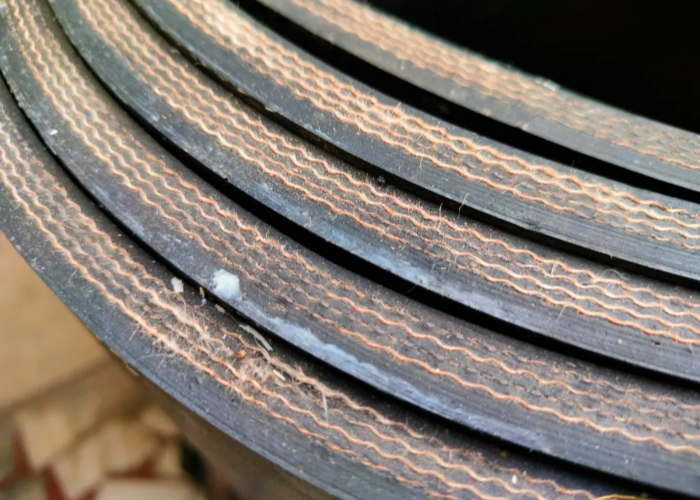
How Conveyor Belt Thickness Affects Performance and Durability
The performance of a conveyor belt system is calculated intricately linked to the thickness of the conveyor belt.
This thickness determines the conveyor belt’s tensile strength, which is crucial for supporting the weight of the materials being transported. It also influences the belt’s ability to conform to the conveyor’s path, especially around curves and over rollers, which can significantly affect the smooth operation of the system.
Durability is another critical factor influenced by conveyor belt thickness. Thicker belts, with more material in the wear layer, can provide longer service life by offering greater resistance to surface wear and abrasions. This resistance is crucial in harsh operating environments where the belt is exposed to aggressive materials or high-impact loads. Additionally, the thickness of the belt affects its resistance to punctures and tears, which can be vital for maintaining operational integrity in environments where sharp objects are common.
The conveyor belt thickness calculation is not just about ensuring that the belt fits within the system. It’s about optimizing the belt’s design to enhance the conveyor system’s overall performance, efficiency, and longevity. By carefully calculating and selecting the appropriate belt thickness, engineers and designers can ensure that the conveyor system operates smoothly, with minimal downtime and maintenance requirements, thereby maximizing the return on investment.
What is the Belt Thickness of Conveyor Belt
The thickness of a conveyor belt varies based on the application, the materials being conveyed, and the design specifications. Here’s how to determine the belt thickness:
Factors Influencing Belt Thickness:
1. Material and Load Requirements:
- The type of material being conveyed (e.g., heavy, abrasive, or lightweight materials) affects the required thickness.
- The load per unit length of the conveyor also plays a role in determining the thickness.
2. Belt Construction:
- Conveyor belts are constructed with different layers, including a carcass (fabric or steel cords) and cover layers (rubber, PVC, etc.).
- The number of plies (layers) in the belt and the thickness of the cover layers contribute to the overall belt thickness.
3. Manufacturer Specifications:
- Manufacturers provide detailed specifications for their belts, including recommended thickness for specific applications.
- Common belt thicknesses range from a few millimeters to several centimeters, depending on the belt type and application.
Example Calculation for Belt Thickness:
1. Determine the Load and Material:
- For a heavy-duty application with abrasive materials, a thicker belt is required.
- Assume a load that requires a tensile strength of 1000 N/mm and uses a belt with 3 plies.
2. Select the Belt Construction:
- A typical heavy-duty belt may have 3 plies with each ply being 1.5 mm thick.
- The cover layers (top and bottom) may add another 3 mm each.
3. Calculate the Total Belt Thickness:

The conveyor belt size (length and width) can be calculated using the conveyor layout and roller dimensions, while the belt thickness is determined by the material properties, load requirements, and manufacturer specifications.
How to Calculate Conveyor Belt Thickness
Calculating the thickness of a conveyor belt involves considering several factors, including the load it will carry, the type of material being conveyed, the belt speed, and the operating conditions. Here is a step-by-step guide to calculating conveyor belt thickness:
Step-by-Step Calculation
Determine the Load per Unit Length:
Calculate the load that the belt will carry per unit length. This is done by dividing the total load by the belt length.

Where:
- ( L_unit}) = Load per unit length (N/m)
- ( F_total) = Total load (N)
- ( L_belt ) = Length of the belt (m)
Calculate the Required Tensile Strength:
Determine the tensile strength required for the belt material to carry the load without breaking.

Where:
- ( T ) = Tensile strength required (N/m)
- ( W_belt) = Width of the belt (m)
Select the Belt Material:
Different materials have different tensile strengths and properties. Select a material suitable for your application, considering factors like abrasion resistance, flexibility, and cost.
Determine the Allowable Stress:
Identify the allowable stress for the chosen belt material. This information can be obtained from material property tables or manufacturer specifications.
Calculate the Cross-Sectional Area:
The cross-sectional area of the belt required to support the tensile strength can be calculated as follows:

Where:
- ( A ) = Cross-sectional area (m²)
- ( σ_allow) = Allowable stress for the belt material (N/m²)
Calculate the Belt Thickness:
Finally, determine the thickness of the belt using the cross-sectional area and the width of the belt.

Where:
- ( t ) = Belt thickness (m)
Example Calculation
Consider the following example:
- Total load ( F_total = 5000 ) N
- Length of the belt ( L_belt = 50 ) m
- Width of the belt ( W_belt = 1 ) m
- Allowable stress for the belt material ( σ_allow = 10 × 10^6 ) N/m²
Calculate the load per unit length:

Calculate the required tensile strength:

Select the belt material:
- Assume we select a material with an allowable stress of ( 10 \times 10^6 ) N/m².
Calculate the cross-sectional area:

Calculate the belt thickness:

This calculated thickness seems very low, suggesting that a more realistic example might require higher loads or different allowable stress values to yield a practical thickness.
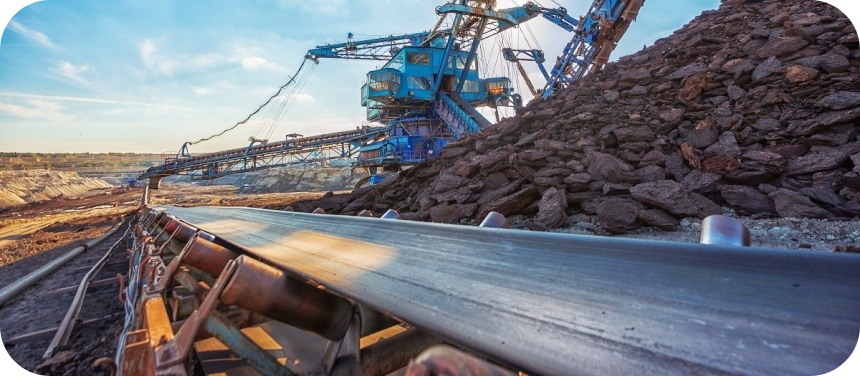
Additional Considerations
- Safety Factor: Incorporate a safety factor into your calculations to account for unexpected loads or conditions.
- Environmental Conditions: Consider environmental factors such as temperature, humidity, and exposure to chemicals, which can affect the belt material and its required thickness.
- Manufacturer Recommendations: Always consult the conveyor belt manufacturer’s specifications and guidelines for specific materials and applications. They may provide more accurate and detailed information tailored to your needs.
Key Resources for Conveyor Belt Thickness Calculation
Overview of Essential Resources for Accurate Thickness Calculation
The process of conveyor belt thickness calculation is supported by a variety of resources designed to provide engineers and designers with the information and tools they need to accurately determine the optimal belt thickness for any given application. These resources range from foundational theoretical documents to practical application guides and comprehensive design handbooks.
Calculating conveyor belt thickness accurately requires using various resources that provide necessary data, formulas, and guidelines. Here are some key resources and tools to consider:
1. Manufacturer Specifications and Catalogs
- Belt Manufacturers: Most conveyor belt manufacturers provide detailed specifications and technical data sheets for their products. These documents typically include tensile strength, allowable stress, material properties, and recommended applications.
- Product Catalogs: Catalogs often contain selection guides, formulas, and charts that help in determining the appropriate belt thickness for specific applications.
2. Industry Standards and Guidelines
- ISO Standards: The International Organization for Standardization (ISO) provides standards such as ISO 14890 (Conveyor Belts – Specification for Rubber or Plastics-Covered Conveyor Belts of Textile Construction) which can be very useful.
- CEMA Standards: The Conveyor Equipment Manufacturers Association (CEMA) provides comprehensive guidelines on conveyor belt design and calculation, including detailed methodologies for determining belt thickness.
- DIN Standards: The German Institute for Standardization (DIN) offers standards like DIN 22101 for the design of belt conveyors and calculation methods.
3. Technical Books and Manuals
- Belt Conveyors for Bulk Materials by CEMA: This is a comprehensive resource that covers all aspects of conveyor belt design, including thickness calculations.
- Engineering Handbooks: Books like “Engineering Handbook” by Goodyear Rubber & Tire Company provide valuable insights and formulas for calculating conveyor belt thickness and other design parameters.
- Belt Conveyor Design Handbook PDFs: For a more comprehensive overview of conveyor belt design, including thickness calculation, design handbooks are invaluable. These documents cover a wide range of topics, from material selection and belt structure to detailed calculation methods and case studies. They provide in-depth guidance on designing conveyor belts that meet specific operational requirements.
- Conveyor Belt Calculations PDFs: These documents offer a foundational understanding of the principles behind conveyor belt design, including the factors that influence belt thickness. They serve as an essential starting point for anyone involved in conveyor belt design or selection.
4. Software Tools
- Belt Analyst by Overland Conveyor: A specialized software that helps in the design and analysis of conveyor systems, providing detailed calculations for belt thickness and other parameters.
- Sidewinder Conveyor Design Software: Another powerful tool for conveyor design, including detailed analysis of belt thickness based on various load and operational conditions.
- Conveyor Belt Thickness Calculation PDFs and Excel Sheets: For practical application, there are numerous PDF guides and Excel sheets available that simplify the process of calculating conveyor belt thickness. These tools typically incorporate standard formulas and allow users to input specific operational parameters to obtain recommended belt thicknesses.
5. Online Calculators and Tools
- Manufacturer Websites: Some conveyor belt manufacturers offer online calculators that allow you to input your specific parameters and obtain recommended belt thickness.
- Engineering Forums and Websites: Platforms like Eng-Tips and various engineering blogs can provide valuable insights and practical examples for calculating belt thickness.
6. Consulting Engineers and Experts
- Professional Consultants: Engaging with engineers who specialize in conveyor systems can provide tailored advice and accurate calculations for your specific application.
- Industry Experts: Participating in industry seminars, webinars, and workshops can provide up-to-date knowledge and best practices for conveyor belt calculations.
7. Case Studies and Research Papers
- Academic Journals: Research papers on conveyor belt design and materials science can offer advanced insights and innovative methods for thickness calculation.
- Industry Publications: Magazines and journals focused on material handling and conveyor systems often feature case studies and technical articles on belt thickness and related topics.
Using a combination of these key resources ensures a thorough and accurate approach to calculating conveyor belt thickness. Manufacturer specifications, industry standards, technical manuals, software tools, online resources, expert consultations, and academic research collectively provide the comprehensive data and methodologies needed for precise calculations.These resources are crucial for ensuring that conveyor belt thickness calculations are performed accurately and effectively. They provide the theoretical background, practical tools, and comprehensive guidelines needed to design conveyor belts that are optimized for performance, durability, and cost-efficiency.
By leveraging these resources, engineers and designers can ensure that their conveyor systems are equipped with belts that are not only fit for purpose but also capable of delivering long-term, reliable performance. Whether through foundational PDFs, practical Excel sheets, or comprehensive design handbooks, the knowledge and tools available for conveyor belt thickness calculation are essential for the successful design and operation of conveyor systems.
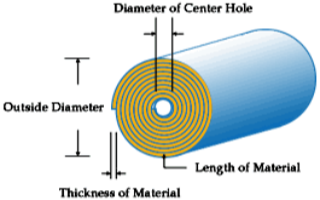
Tools and Software for Conveyor Belt Thickness Calculation
Introduction to Advanced Tools and Software Solutions
The accurate calculation of conveyor belt thickness is crucial for the design, operation, and maintenance of conveyor systems. Advanced tools and software have been developed to assist engineers and technicians in performing precise conveyor belt thickness calculations. These tools range from Excel-based formulas to sophisticated online calculators, each designed to facilitate the complex calculations required to determine the optimal conveyor belt for specific applications.
Belt Conveyor Calculation Excel Free Download Resources
Excel spreadsheets are widely used in the industry for conveyor belt calculations due to their flexibility and accessibility. These sheets allow for the input of key parameters such as belt speed, load per unit length, and conveyor length, to calculate the required belt thickness. Excel-based tools often come with pre-programmed formulas capable of handling various calculations related to belt tension, load distribution, and the belt’s structural integrity. Users can find numerous belt conveyor calculation Excel free download resources online, provided by manufacturers, engineering forums, and professional organizations. These resources serve as a starting point for customizing calculations to fit specific conveyor system requirements.
Online Tools for Belt Conveyor Calculation
In addition to Excel spreadsheets, several online tools offer user-friendly interfaces for conveyor belt calculations. These web-based calculators are accessible from anywhere and provide instant results without the need for software installation. They cover a wide range of calculations, including belt length, speed, and power requirements, along with the critical conveyor belt thickness calculation. Online tools often feature interactive elements, such as sliders and dropdown menus, allowing users to easily modify input values and understand how changes affect the overall conveyor belt design.
These advanced tools and software solutions are indispensable for ensuring the accurate calculation of conveyor belt thickness, thereby enhancing the efficiency, safety, and longevity of conveyor systems.
Calculating the thickness of a conveyor belt accurately requires specialized tools and software that can handle the complexities of belt design and material properties. Here are some of the best tools and software available for conveyor belt thickness calculation:
1. Belt Analyst by Overland Conveyor
- Overview: Belt Analyst is a powerful tool specifically designed for the analysis and design of conveyor belt systems. It offers detailed calculations for belt thickness, among other parameters.
- Features:
- Comprehensive belt design capabilities
- Accurate calculation of belt tension and power requirements
- Simulation of different operating conditions
- Integration with CAD software for detailed design layouts
2. Sidewinder Conveyor Design Software
- Overview: Sidewinder is another leading software tool for conveyor system design, including thickness calculations.
- Features:
- Advanced conveyor design algorithms
- Detailed analysis of belt thickness based on load and operational conditions
- Real-time simulation of conveyor performance
- Extensive database of belt materials and their properties
3. CONTI Professional by Continental
- Overview: CONTI Professional is a software suite provided by Continental for conveyor belt design and analysis.
- Features:
- Calculation of belt thickness based on load and stress factors
- Comprehensive database of belt materials
- Tools for optimizing conveyor system efficiency
- Detailed reporting and documentation capabilities
4. Helix Delta-T
- Overview: Helix Delta-T is an industry-standard software for the design and optimization of conveyor belts.
- Features:
- Detailed belt thickness calculations
- Accurate modeling of conveyor dynamics
- Integration with other engineering software
- Extensive material database
5. Fenner Dunlop Conveyor Design Software
- Overview: Fenner Dunlop provides proprietary software tools for the design and analysis of conveyor belts.
- Features:
- Calculation of belt thickness and other design parameters
- Material selection guides
- Simulation of various operational scenarios
- User-friendly interface
6. Dodge Passport by ABB
- Overview: Dodge Passport is a web-based software tool provided by ABB for designing mechanical power transmission components, including conveyor belts.
- Features:
- Belt thickness calculation based on load and stress analysis
- Integration with ABB’s extensive product database
- Real-time collaboration capabilities
- Detailed design documentation
7. MITCalc
- Overview: MITCalc is a comprehensive engineering calculation software that includes modules for conveyor belt design.
- Features:
- Calculation of belt thickness based on material properties and load conditions
- Extensive library of engineering formulas
- Integration with CAD software
- Customizable calculation modules
8. B_Rex by Beckhoff
- Overview: B_Rex is a software tool designed for the calculation of conveyor belt systems, including thickness calculations.
- Features:
- Detailed analysis of belt thickness
- Simulation of belt performance under different load conditions
- Integration with Beckhoff’s automation products
- User-friendly interface
9. Online Calculators
- Overview: Several manufacturers and engineering websites offer online calculators for conveyor belt thickness calculation.
- Examples:
- Habasit: Offers an online tool for calculating conveyor belt thickness and other design parameters.
- Ammeraal Beltech: Provides an online calculator for belt design and thickness determination.
Using these specialized tools and software ensures accurate and efficient calculation of conveyor belt thickness. Whether you need comprehensive design capabilities, real-time simulation, or integration with other engineering systems, these tools provide the necessary features to optimize your conveyor belt design and performance.
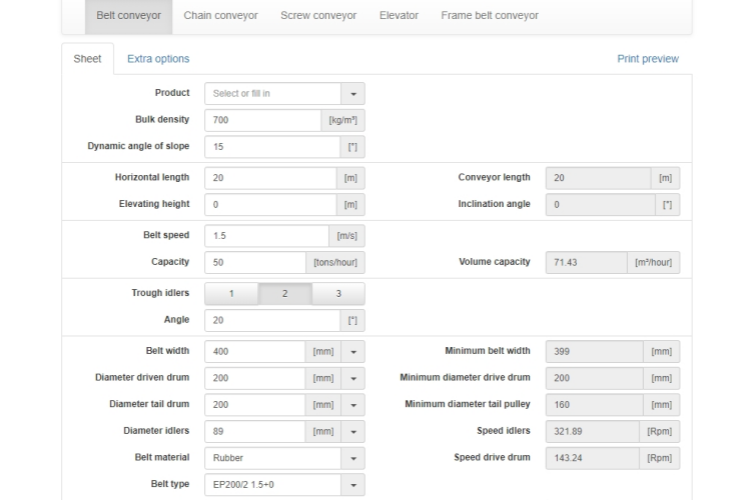
Practical Guide to Using Conveyor Belt Thickness Calculation Excel Sheets
Utilizing Excel Sheets for Conveyor Belt Thickness Calculations
Excel sheets are invaluable tools in the realm of conveyor belt design and maintenance, offering a versatile platform for performing a wide array of calculations, including the pivotal conveyor belt thickness calculation. This section provides a practical guide on how to effectively use Excel sheets for this purpose, ensuring accurate and reliable results.
Step-by-Step Guide
- Download or Create an Excel Sheet: Start by downloading a pre-made Excel sheet designed for conveyor belt calculations or create your own based on the specific requirements of your project. Ensure that the sheet includes formulas for calculating belt thickness based on inputs such as belt tension, material load, belt speed, and environmental factors.
- Input Basic Conveyor System Parameters: Enter the basic information about your conveyor system, including the type of material being transported, conveyor length, belt speed, and maximum load. This foundational data is critical for accurate thickness calculations.
- Enter Material and Belt Properties: Input detailed information about the material properties, such as bulk density and abrasiveness, as well as existing data on the conveyor belt material. These factors significantly influence the required belt thickness.
- Use Formulas for Thickness Calculation: Utilize the embedded formulas within the Excel sheet to calculate the optimal belt thickness. These formulas typically consider the belt’s tensile strength, the weight of the material load, and the belt’s speed to determine the necessary thickness for safe and efficient operation.
- Adjust for Safety Factors: Incorporate safety factors into your calculations to account for unexpected stresses and potential inaccuracies in material property data. Safety factors ensure that the chosen belt thickness will suffice under all operational conditions.
- Interpret Results and Make Decisions: Analyze the calculated belt thickness in the context of available belt options and make informed decisions regarding belt selection. Consider factors such as cost, availability, and compatibility with existing conveyor components.
- Validate with Real-World Testing: Whenever possible, validate your Excel-based calculations with real-world testing or consult with belt manufacturers to ensure that the selected belt meets the operational demands of your conveyor system.
Our conveyor belts are engineered for excellence. Contact us to learn more!
Tips for Accurate Data Entry and Interpretation
- Double-Check All Inputs: Ensure accuracy in the data entered into the Excel sheet, as even minor errors can lead to significant miscalculations.
- Understand the Formulas: Familiarize yourself with the underlying principles of the conveyor belt thickness calculation formulas to better interpret the results.
- Consult with Experts: When in doubt, consult with conveyor belt manufacturers or engineering experts to verify calculations and obtain recommendations.
Excel sheets for conveyor belt thickness calculations provide a flexible and accessible means for determining the optimal belt for specific applications. By following this practical guide, users can achieve accurate calculations that contribute to the safe and efficient operation of conveyor systems.
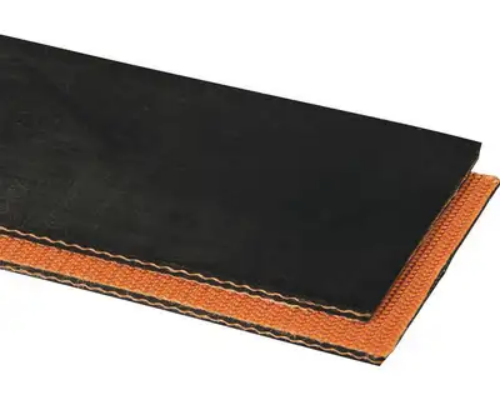
Case Studies: Conveyor Belt Thickness Calculation in Action
Introduction
Real-world applications of conveyor belt thickness calculation demonstrate its importance across various industries. These case studies highlight how accurate calculations contribute to system efficiency, safety, and cost-effectiveness.
Understanding the practical applications of conveyor belt thickness calculation can provide valuable insights into the complexities and benefits of precise design. Here are some detailed case studies that showcase how accurate conveyor belt thickness calculations have been applied in various industries.
Case Study 1: Heavy Manufacturing Plant
Background:
A heavy manufacturing plant specializing in steel production was facing frequent motor failures and high maintenance costs due to the high starting torque required for their rolling mills. The existing conveyor belts were not adequately designed to handle the heavy loads and intense operational conditions.
Challenges:
- High starting torque causing excessive strain on motors and belts
- Frequent downtime and maintenance issues
- Need for improved durability and performance
Solution:
Using Belt Analyst by Overland Conveyor, the plant engineers performed a detailed analysis and calculation of the conveyor belt thickness. The software helped in:
- Determining the optimal belt thickness to handle the high loads and reduce strain on the motors
- Selecting materials with appropriate tensile strength and durability
- Simulating different operational scenarios to ensure reliability
Results:
- A new conveyor belt with increased thickness and improved material properties was installed
- Significant reduction in motor failures and maintenance costs
- Enhanced operational efficiency and prolonged equipment lifespan
Case Study 2: Mining Operation
Background:
A mining company operating large underground hoists required a solution to manage the high starting torque and heavy loads associated with lifting mined materials. The existing belts were wearing out quickly and causing operational delays.
Challenges:
- High abrasion and wear due to heavy, abrasive materials
- Frequent belt replacements leading to increased downtime and costs
- Need for a robust and durable conveyor belt solution
Solution:
Using Sidewinder Conveyor Design Software, the engineering team calculated the necessary conveyor belt thickness to withstand the harsh mining environment. Key steps included:
- Calculating the load per unit length and required tensile strength
- Selecting a belt material with high abrasion resistance
- Determining the appropriate thickness to handle the heavy loads without excessive wear
Results:
- Installation of a thicker, more durable conveyor belt
- Extended belt life and reduced replacement frequency
- Improved overall productivity and reduced operational costs
Case Study 3: Water Treatment Facility
Background:
A water treatment facility experienced frequent issues with water hammer and pipeline stress due to abrupt starts of their large pumps. The existing conveyor belts were not adequately designed to handle the fluctuating loads and pressures.
Challenges:
- Preventing water hammer effects and mechanical stress on pipelines
- Ensuring smooth and controlled start-up of pumps
- Reducing maintenance and operational disruptions
Solution:
The facility used Helix Delta-T software to perform a detailed analysis and calculation of the conveyor belt thickness. This involved:
- Determining the optimal belt thickness to ensure smooth acceleration and minimize mechanical stress
- Selecting materials suitable for the wet and corrosive environment
- Simulating different start-up scenarios to optimize performance
Results:
- Installation of a new conveyor belt with optimized thickness and material properties
- Elimination of water hammer effects and reduced mechanical stress on pipelines
- Enhanced system reliability and reduced maintenance requirements
Case Study 4: Power Generation Plant
Background:
A power generation plant needed precise control over the speed and torque of their induced draft fans to maintain optimal combustion efficiency in the boilers. The existing conveyor belts were not providing the necessary control, leading to inefficiencies and increased wear.
Challenges:
- Ensuring precise speed and torque control for induced draft fans
- Reducing wear and tear on the belts and associated equipment
- Maintaining optimal combustion efficiency
Solution:
Using CONTI Professional by Continental, the plant engineers calculated the required conveyor belt thickness. The software allowed them to:
- Calculate the exact thickness needed to handle the operational loads and provide precise control
- Select appropriate belt materials to withstand the high temperatures and stresses
- Simulate various operational conditions to ensure optimal performance
Results:
- Installation of a new, thicker conveyor belt with enhanced control capabilities
- Improved combustion efficiency and reduced wear on the equipment
- Lower maintenance costs and increased equipment lifespan
Analysis of Contributions to Efficiency, Safety, and Cost-Effectiveness
- Efficiency: Proper belt thickness calculation ensures that the conveyor system operates smoothly, with minimal downtime and maintenance, thereby enhancing overall productivity.
- Safety: By selecting a belt of adequate thickness and durability, the risk of belt failure and related accidents is significantly reduced, promoting a safer working environment.
- Cost-Effectiveness: Accurate thickness calculations lead to informed decision-making, allowing for the selection of belts that offer the best return on investment through reduced maintenance costs and extended service life.
These case studies underscore the value of precise conveyor belt thickness calculation in optimizing conveyor system performance across a wide range of industries.
These case studies demonstrate the critical importance of accurate conveyor belt thickness calculation in various industrial applications. Using specialized tools and software, engineers can ensure that conveyor belts are properly designed to handle specific operational demands, leading to improved performance, reduced maintenance costs, and enhanced reliability.
Ensure your operations run smoothly with our top-notch conveyor belts. Get in touch today!
FAQs about Conveyor Belt Thickness Calculation
To measure conveyor belt thickness, use a precise thickness gauge or caliper. Place the gauge or caliper against the edge of the conveyor belt where it’s free of any wear or deformations. Ensure the tool is perpendicular to the surface for an accurate measurement. Record the measurement at various points along the belt to get an average thickness.
The formula for calculating the length of a conveyor belt in a roll involves the roll diameter, the core diameter, and the belt thickness. It can be expressed as:
L = (D^2 – d^2) * π / (4 * T)
where:
L is the length of the belt in meters,
D is the diameter of the roll in meters,
d is the diameter of the core in meters,
T is the thickness of the belt in meters,
π (pi) is a constant (approximately 3.14159).
For calculating the speed of the conveyor belt, you can use:
V = D * π * N / 60
where:
V is the belt speed in meters per second,
D is the diameter of the pulley in meters,
N is the rotation speed of the pulley in revolutions per minute (RPM),
π (pi) is a constant (approximately 3.14159).
The thickness of a 2 ply conveyor belt typically ranges from about 5 to 8 millimeters. However, the exact thickness can vary depending on the specific material used for the plies and the type of rubber or coating applied to the belt. It’s important to refer to the manufacturer’s specifications for precise measurements.
A 3 ply conveyor belt thickness generally ranges from about 6 to 12 millimeters. Similar to 2 ply belts, the exact thickness of a 3 ply conveyor belt can vary based on the materials used for the plies and the presence of any coatings or rubber layers. Manufacturer specifications should be consulted for accurate thickness measurements.
Calculating the size of a conveyor belt involves determining both its length and width to ensure it fits your specific conveyor system requirements. Here’s a detailed, step-by-step guide on how to calculate conveyor belt size:
Step 1: Determine the Conveyor Layout
First, identify the type of conveyor system you have, whether it’s a flat belt, inclined, declined, or a roller conveyor. The layout will influence the length and width calculations. Measure the overall length of the conveyor path, considering any bends or curves if applicable.
Step 2: Measure the Roller Diameter
Measure the diameter of the head and tail rollers (or pulleys). If the diameters are the same, you can use one value; otherwise, consider each pulley’s diameter individually. This measurement is crucial for determining the belt length.
Step 3: Calculate the Conveyor Belt Length
For a simple horizontal conveyor system, you can use the following formula to calculate the belt length:
L=2C+(π×D)+(D×D)/4C
Where:
L = Length of the conveyor belt
C = Distance between the centers of the head and tail pulleys (center-to-center distance)
D = Diameter of the pulleys
For inclined or declined conveyors, consider the angle of the incline or decline, adjusting the center-to-center distance accordingly.
Last Updated on June 7, 2024 by Jordan Smith
Jordan Smith, a seasoned professional with over 20 years of experience in the conveyor system industry. Jordan’s expertise lies in providing comprehensive solutions for conveyor rollers, belts, and accessories, catering to a wide range of industrial needs. From initial design and configuration to installation and meticulous troubleshooting, Jordan is adept at handling all aspects of conveyor system management. Whether you’re looking to upgrade your production line with efficient conveyor belts, require custom conveyor rollers for specific operations, or need expert advice on selecting the right conveyor accessories for your facility, Jordan is your reliable consultant. For any inquiries or assistance with conveyor system optimization, Jordan is available to share his wealth of knowledge and experience. Feel free to reach out at any time for professional guidance on all matters related to conveyor rollers, belts, and accessories.




